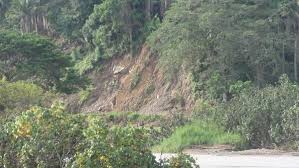
Erosion (beta ver. 1.0)
We recommend that you clear as little vegetation as possible for your driveway, house site and infrastructure. Earthworks can cause damage to tree roots resulting in die-back and tree fall, causes the adjacent forest to dry out, and may introduce diseases and weeds to your property. These in turn can result in erosion damage on your property and elsewhere in the forest.
The coastal zone is notably prone to erosion, especially on slopes and close to waterways. Waterways distribute seeds, spreading weeds to areas downstream where these invasive plants destabilise the banks by outcompeting natives, causing erosion. This is especially the case where the surrounding land has been cleared and cultivated. For this reason, clearing in riparian zones (30m from perennial and ephemeral waterways) is high impact and difficult to reverse. Selective removal of small trees by hand and working around the bigger trees may be all that you need to do. If you must clear, leaving a buffer zone or regrowth around old-growth areas and removing only the understory will reduce this damage. The rainforest canopy is home to many threatened and endemic species and is much harder to replace.
It's also recommended, and may be required, that you have ecological and cultural heritage surveys done before doing any clearing or earthmoving. All of our properties are potentially home to rare and threatened plants as well as significant cultural heritage. Habitat loss is already at a critical level. Once the forest has been cleared it may take many years to or may never regenerate to its pre-cleared state.
In the wet season, run-off from unsealed roads is high and the impact is visible in adjacent lagoons and seagrass beds. Driving on the beach compacts the sand, damaging habitat of fauna living in the sand and destroys dune vegetation, resulting in erosion. Sedimentation from this erosion affects the coral's ability to capture sunlight and regenerate, especially after cyclones and it promotes algal growth that kills the corals. There is also likely to be greater tidal movement with increased severe weather events, such as cyclones, that will have an impact on the aquatic system.
You can help repair erosion by filling the start of erosion gullies with native brush, especially fast growing natives with extensive root systems, at the end of the wet season. This will help stabilise the soil and also catch seeds to aid natural regeneration.
Download the complete Erosion Factsheet (pdf, [file size]). Erosion damage and repair: clearing and earthworks; weeds; weather; and regeneration.
Related Factsheets
